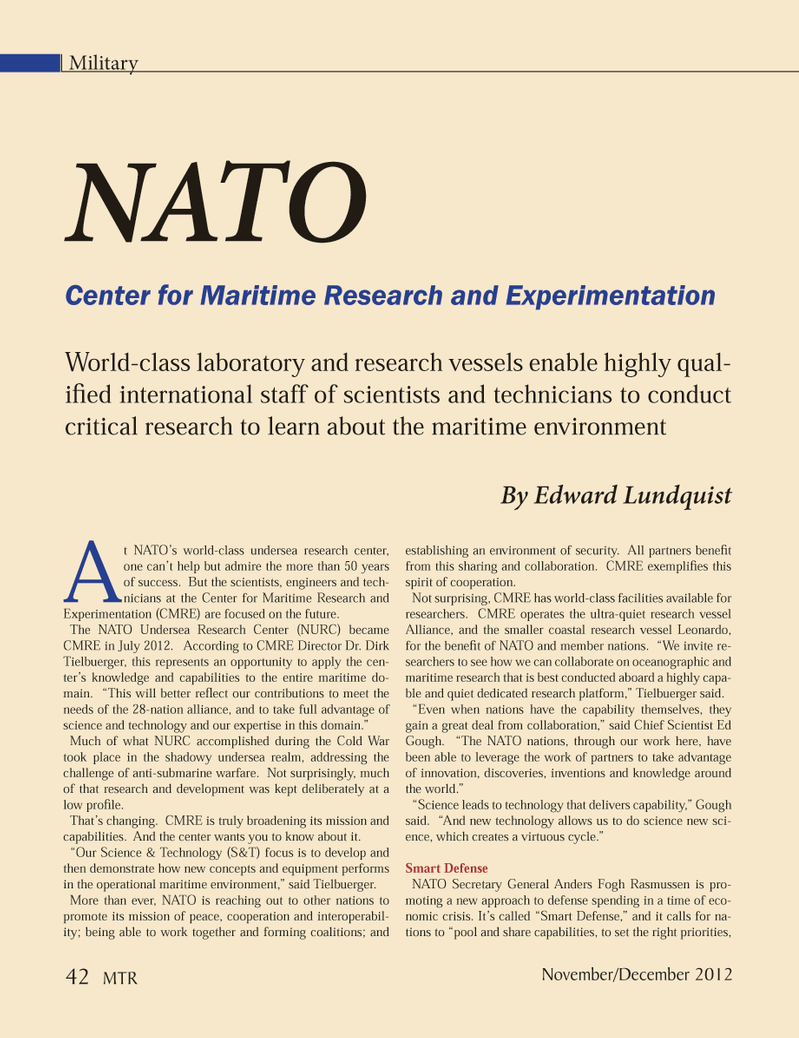
Page 42: of Marine Technology Magazine (November 2012)
Fresh Water Monitoring & Sensors
Read this page in Pdf, Flash or Html5 edition of November 2012 Marine Technology Magazine
At NATO?s world-class undersea research center, one can?t help but admire the more than 50 years of success. But the scientists, engineers and tech-nicians at the Center for Maritime Research and Experimentation (CMRE) are focused on the future.The NATO Undersea Research Center (NURC) became CMRE in July 2012. According to CMRE Director Dr. Dirk Tielbuerger, this represents an opportunity to apply the cen- ter?s knowledge and capabilities to the entire maritime do- main. ?This will better re ect our contributions to meet the needs of the 28-nation alliance, and to take full advantage of science and technology and our expertise in this domain.? Much of what NURC accomplished during the Cold War took place in the shadowy undersea realm, addressing the challenge of anti-submarine warfare. Not surprisingly, much of that research and development was kept deliberately at a low pro le. That?s changing. CMRE is truly broadening its mission and capabilities. And the center wants you to know about it. ?Our Science & Technology (S&T) focus is to develop and then demonstrate how new concepts and equipment performs in the operational maritime environment,? said Tielbuerger. More than ever, NATO is reaching out to other nations to promote its mission of peace, cooperation and interoperabil-ity; being able to work together and forming coalitions; and establishing an environment of security. All partners bene t from this sharing and collaboration. CMRE exempli es this spirit of cooperation.Not surprising, CMRE has world-class facilities available for researchers. CMRE operates the ultra-quiet research vessel Alliance, and the smaller coastal research vessel Leonardo, for the bene t of NATO and member nations. ?We invite re- searchers to see how we can collaborate on oceanographic and maritime research that is best conducted aboard a highly capa-ble and quiet dedicated research platform,? Tielbuerger said. ?Even when nations have the capability themselves, they gain a great deal from collaboration,? said Chief Scientist Ed Gough. ?The NATO nations, through our work here, have been able to leverage the work of partners to take advantage of innovation, discoveries, inventions and knowledge around the world.? ?Science leads to technology that delivers capability,? Gough said. ?And new technology allows us to do science new sci- ence, which creates a virtuous cycle.? Smart DefenseNATO Secretary General Anders Fogh Rasmussen is pro- moting a new approach to defense spending in a time of eco-nomic crisis. It?s called ?Smart Defense,? and it calls for na- tions to ?pool and share capabilities, to set the right priorities, Military NATO Center for Maritime Research and Experimentation World-class laboratory and research vessels enable highly qual- i ed international staff of scientists and technicians to conduct critical research to learn about the maritime environment By Edward Lundquist November/December 201242 MTRMTR #9 (34-49).indd 42MTR #9 (34-49).indd 4212/3/2012 11:30:46 AM12/3/2012 11:30:46 AM

 41
41

 43
43
